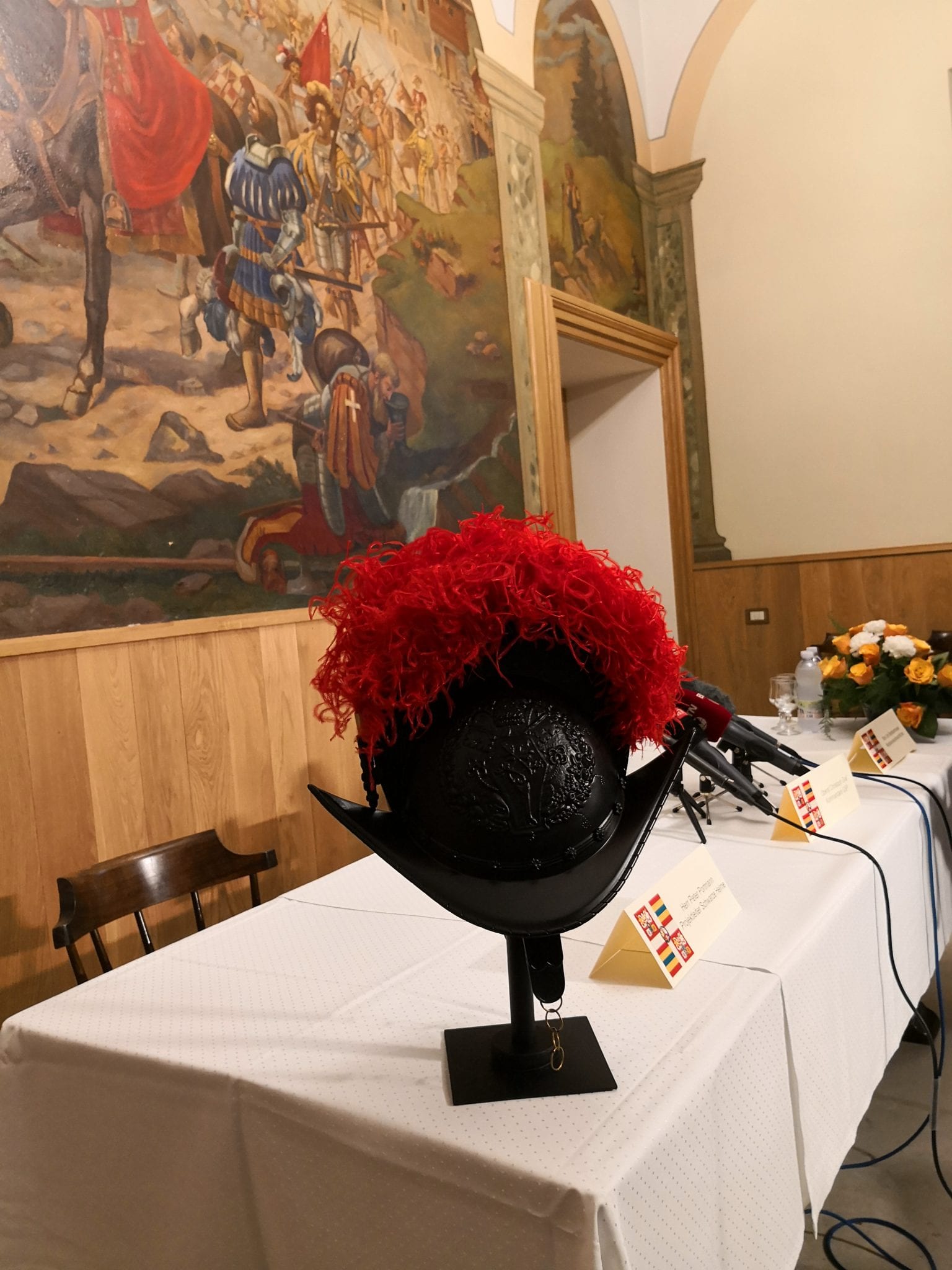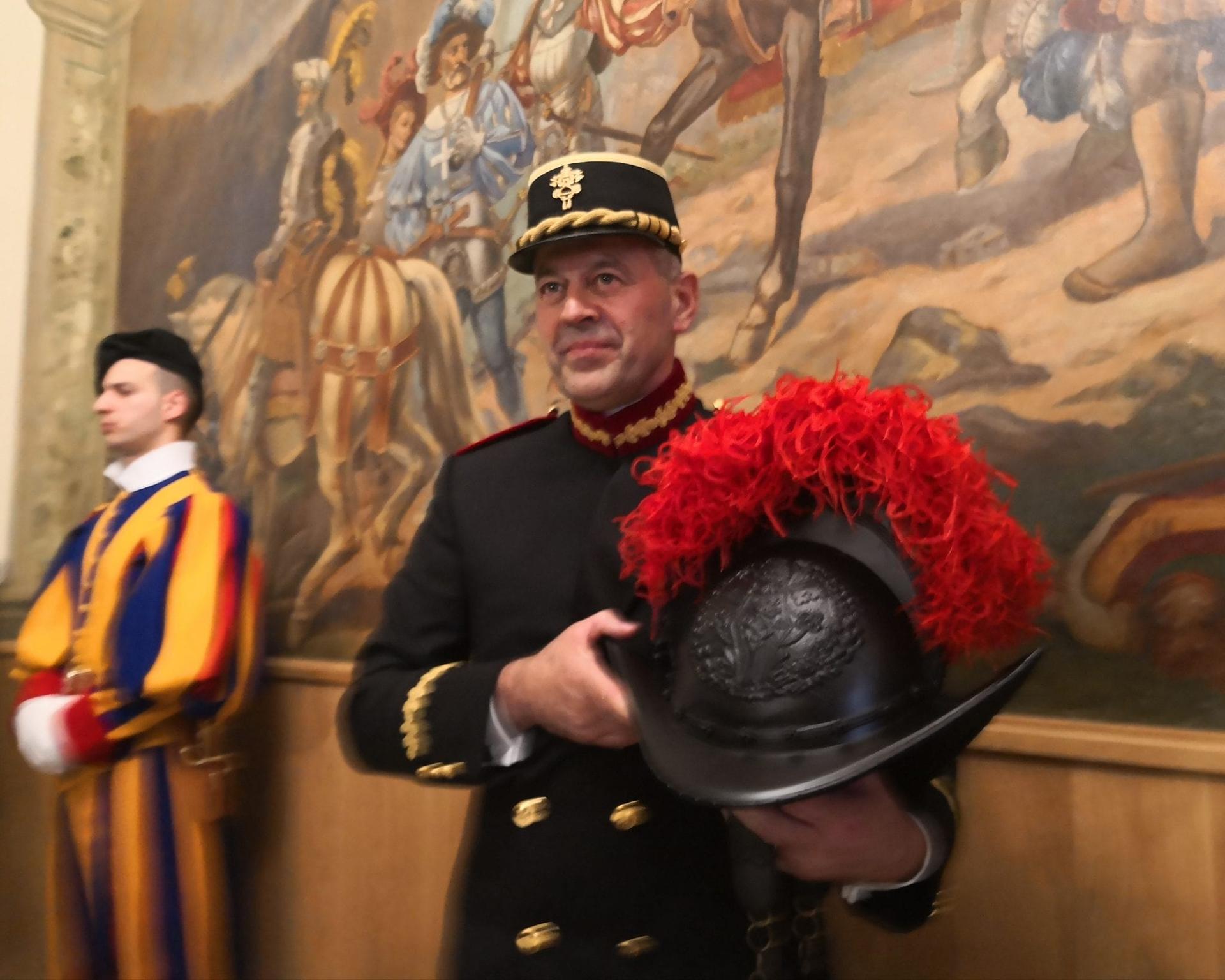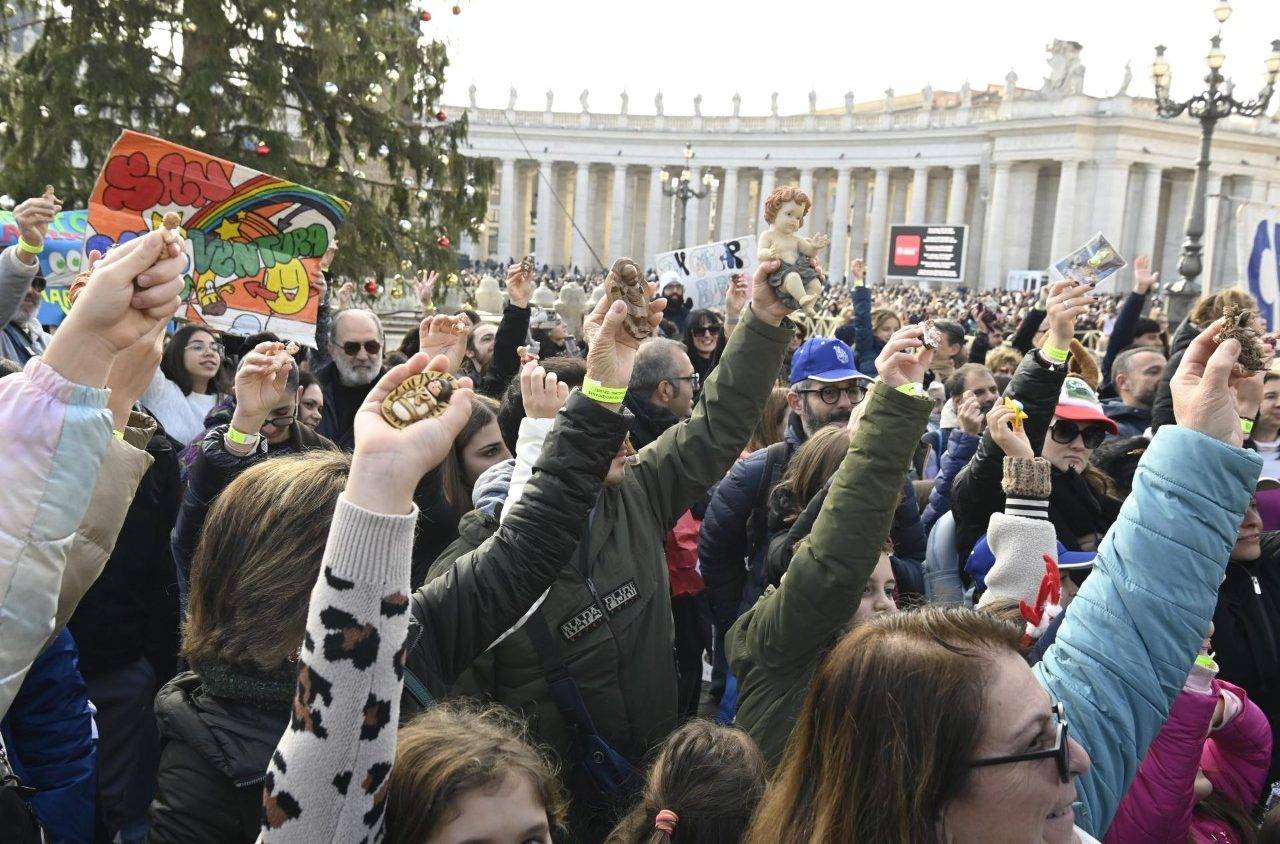ROME – Just as New York readies to host the biggest night of the fashion world’s annual calendar tomorrow night at the Met Gala, this time with a Catholic theme, back in Rome the Swiss Guard made a fashion statement of its own on Friday.
Perhaps the world’s smallest army, and certainly one of its most celebrated, the Guard debuted an early look Friday at a much lighter version of their traditional cast iron helmets, which are being produced in PVC with the aid of 3D printing technology.
Designed mostly to resemble the old helmets, the new version nonetheless does sport another distinctive touch: The coat of arms of Pope Julius II, who instituted the army in 1506. They should be ready for use sometime in 2019.
Hence the stylish new helmets won’t be worn today for the Swiss Guard’s annual swearing-in ceremony, in which 33 new members will swear to “faithfully, loyally and honorably serve the supreme pontiff,” in a ceremony that, despite the absence of the pope, is usually one of Rome’s hottest tickets during the month of May.
It always takes place on the same day, May 6, on the anniversary of the sack of Rome in 1527. On that date, 147 soldiers died protecting Pope Clement VII.
The ceremony is one of pomp and circumstance. The entire army, close to 110 men on Sunday, will be in full dress uniform, accompanied in the Vatican’s St. Damaso Courtyard by religious personalities and political and military representatives of Switzerland, a country Francis will visit later this year.
The new helmets were presented on Friday in Rome during a press event ahead of Sunday’s ceremony.

According to Commander Christoph Graf, the helmets have been purchased through what might be considered an informal crowdfunding campaign, led by layman Peter Portmann, introduced on Friday as a “friend of the Swiss Guards.”
The new helmets come at a price of roughly $1,000, half of what the older ones cost.
Portmann was the man behind the idea of printing this mostly ceremonial element of the uniform, as it’s been some time since a Swiss Guard actually wore one into battle. Together with his friends, he’s paying for the production.
Among the many benefits of the new helmets, which will be used when the pope welcomes a head of state, or an ambassador presenting their credential letters, is the fact that it weighs far less than those cast in iron, which guard members say would overheat during Rome’s summer days and sometimes burn their heads.
Who are the Swiss Guards?
The contingent of highly trained guards was born of an alliance between the Swiss and the Holy Roman empire, and they’ve been protecting the pontiff for more than 500 years.
To be eligible for the job, which pays $1,800 a month courtesy of the pope, one has to be male, Catholic, single, a Swiss citizen, aged between 19 and 30, at least 5’8″, and willing to be a member of the guard for at least two years.
If you run into the Swiss Guards at the Vatican, either guarding the doors or during the pope’s public events in St. Peter’s Basilica and/or Square, don’t let their colored uniforms in shades of blue, red, orange and yellow reminiscent of the Renaissance fool you: All of them have received basic Swiss military training, and are prepared in unarmed combat and small arms.
When it comes to what Graf looks for in new recruits, he said a key thing is their ability to be a part of the group. Since the guards live and work together in very small quarters, being able to get along is central.
Hence, he said, “many forge friendships that last a lifetime.”
Graf said that also fundamental in the life of the guards is their faith, even if “because of the situation in Switzerland,” not all recruits are Mass-going Catholics.
“If we only accepted guards who go to Mass every Sunday, who receive the sacraments regularly, the army wouldn’t exist anymore,” he said.
Therefore, for him, evangelizing is part of his mission: “We need to give the young men the possibility of growing in their faith. I believe that with the closeness to the Holy Father, those who have an open heart are able to discover the faith.”
“It’s part of our job, as officials, to be witness, not to be afraid to talk about our faith, something that is no longer done in Switzerland,” Graf said.
Nicolas Albert, 19, is one of the new recruits who on Sunday will swear to give his life for the pope if necessary. He told Crux that ever since he was a child he “dreamed” of becoming one of the guards with “a shiny armor.”
Eventually the dream was forgotten, but in his junior year of high school, a friend invited him to apply together, reviving that childhood passion. He joined the Swiss army and was eventually admitted to be one of the pope’s private soldiers.
“There’s also a spiritual motivation behind my joining the army, and that’s broadening my faith,” Albert said.
Safety concerns, due to terrorism and the pope’s “Latin ways”
Asked about an increased security regarding the constant threats of terrorist attacks in Europe, Graf first said that he didn’t want to talk about it, because “I know what you [journalists] will write.”
However, he acknowledged it’s evident in the area surrounding the Vatican what the Italian government does to guarantee the safety of tourists and pilgrims. Though he didn’t specify, in recent years the presence of military vehicles along with large cement plant-pots blocking access to Via della Conciliazione, the famous avenue that leads to St. Peter’s Square have been obvious.
“We can say that the guards are more attentive,” he said. “I see that 10 or 15 years ago, the Swiss Guards were more at ease, but the situation has unfortunately changed in recent years.”
Despite their training, the men guarding the pope don’t have heavy artillery, tanks or planes.
“What we have is faith, hope and charity,” Graf said, listing the three theological virtues. “We cannot always speak of guns, but also about other ways to defeat war, such as faith and prayer.”
Asked about Pope Francis’s proclivity to go out of his way to greet as many pilgrims as he can wherever he goes, Graf said that at the beginning, they weren’t necessarily ready.
“We, who come from northern countries, found it to be something new. But when you think about it, it’s normal that he wants to hug a person,” he said. “After five years, we’ve gotten used to it.”














